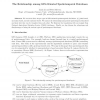Free Online Productivity Tools
i2Speak
i2Symbol
i2OCR
iTex2Img
iWeb2Print
iWeb2Shot
i2Type
iPdf2Split
iPdf2Merge
i2Bopomofo
i2Arabic
i2Style
i2Image
i2PDF
iLatex2Rtf
Sci2ools
DGO
2003
2003
The Relationship among GIS-Oriented Spatiotemporal Databases
: We overview three major types of GIS-oriented spatiotemporal databases: (1) point-based, (2) region-based, and (3) constraint-based. We analyze the relationship among these spatiotemporal databases and show how they can be translated into each other. We illustrate the translations with an example from National Agricultural Statistics Service (NASS) databases. Finally, we also discuss the advantages and disadvantages of using the various types of spatiotemporal databases.
DGO 2003 | DGO 2007 | GIS-oriented Spatiotemporal Databases | National Agricultural Statistics Service | Spatiotemporal Databases |
| Added | 31 Oct 2010 |
| Updated | 31 Oct 2010 |
| Type | Conference |
| Year | 2003 |
| Where | DGO |
| Authors | Lixin Li, Peter Z. Revesz |
Comments (0)

